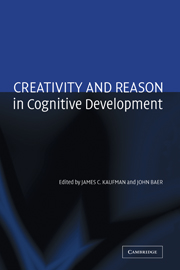Book contents
- Frontmatter
- Contents
- List of Contributors
- Acknowledgments
- Creativity and Reason in Cognitive Development
- Introduction
- COGNITIVE PERSPECTIVES
- 1 Expertise and Reason in Creative Thinking: Evidence from Case Studies and the Laboratory
- 2 Creative Genius, Knowledge, and Reason: The Lives and Works of Eminent Creators
- 3 Dynamic Processes Within Associative Memory Stores: Piecing Together the Neural Basis of Creative Cognition
- 4 The Creativity of Everyday Moral Reasoning: Empathy, Disgust, and Moral Persuasion
- 5 Reasoning and Personal Creativity
- 6 Alternative Knowledge Structures in Creative Thought: Schema, Associations, and Cases
- 7 The Role of the Knowledge Base in Creative Thinking
- 8 The Role of Domain Knowledge in Creative Problem Solving
- 9 Creative Thinking and Reasoning: Can You Have One Without the Other?
- 10 From Alexithymia, Borne of Trauma and Oppression, to Symbolic Elaboration, the Creative Expression of Emotions, and Rationality
- 11 Opening up Creativity: The Lenses of Axis and Focus
- DEVELOPMENTAL AND EDUCATIONAL PERSPECTIVES
- Author Index
- Subject Index
- References
2 - Creative Genius, Knowledge, and Reason: The Lives and Works of Eminent Creators
Published online by Cambridge University Press: 19 January 2010
- Frontmatter
- Contents
- List of Contributors
- Acknowledgments
- Creativity and Reason in Cognitive Development
- Introduction
- COGNITIVE PERSPECTIVES
- 1 Expertise and Reason in Creative Thinking: Evidence from Case Studies and the Laboratory
- 2 Creative Genius, Knowledge, and Reason: The Lives and Works of Eminent Creators
- 3 Dynamic Processes Within Associative Memory Stores: Piecing Together the Neural Basis of Creative Cognition
- 4 The Creativity of Everyday Moral Reasoning: Empathy, Disgust, and Moral Persuasion
- 5 Reasoning and Personal Creativity
- 6 Alternative Knowledge Structures in Creative Thought: Schema, Associations, and Cases
- 7 The Role of the Knowledge Base in Creative Thinking
- 8 The Role of Domain Knowledge in Creative Problem Solving
- 9 Creative Thinking and Reasoning: Can You Have One Without the Other?
- 10 From Alexithymia, Borne of Trauma and Oppression, to Symbolic Elaboration, the Creative Expression of Emotions, and Rationality
- 11 Opening up Creativity: The Lenses of Axis and Focus
- DEVELOPMENTAL AND EDUCATIONAL PERSPECTIVES
- Author Index
- Subject Index
- References
Summary
Many creative geniuses attain reputations of almost mythical proportions. Apparently gifted with a special insight or intuitive power, creative ideas are supposed to pop into their heads in flashes of inspiration. In earlier times, this almost mystical process would be attributed to divine intervention, as is evident in the Greek doctrine of the Muses. Even during the Renaissance the greatest artist of the period would be called the “divine Michelangelo,” an artistic genius who, according to his biographer Vasari, was sent to earth by God to bless the world with his talent. Centuries later, when such religious attributions were no longer fashionable, creative genius would become linked with madness. This linkage became especially prominent during the Romantic Era of 19th-century Europe. A well-known illustration is to be found in the Preface to Kublai Khan in which the poet Coleridge claimed to have conceived his poem in an opium-induced stupor. Eventually psychiatrists, psychoanalysts, and even psychologists were joining the chorus, associating creative genius with insanity and even criminality. The consensus seemed to be that creative geniuses were not like normal human beings. They had thought processes and personalities that set them apart from other members of the species.
Yet at the beginning of the 20th century a shift was taking place. Creative genius was not so special after all. This change first was apparent in attitudes toward scientific creativity.
- Type
- Chapter
- Information
- Creativity and Reason in Cognitive Development , pp. 43 - 59Publisher: Cambridge University PressPrint publication year: 2006
References
- 8
- Cited by

